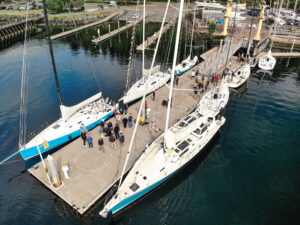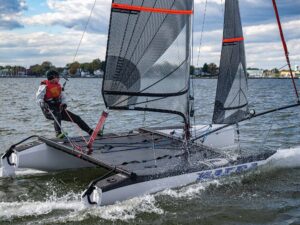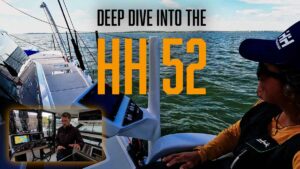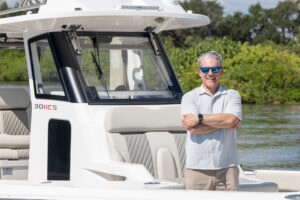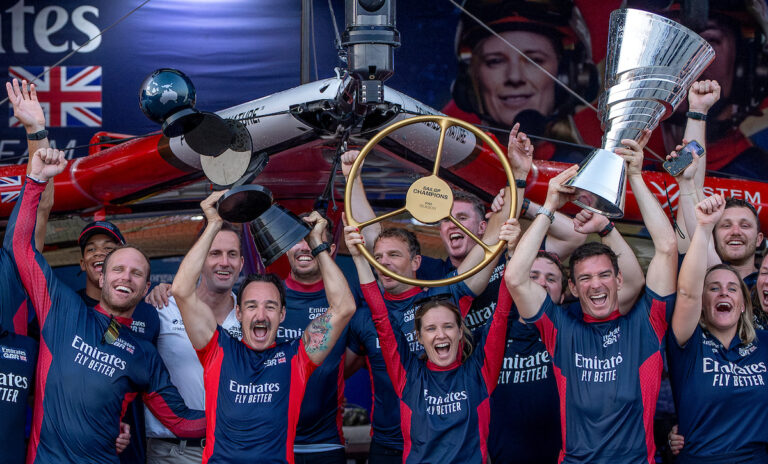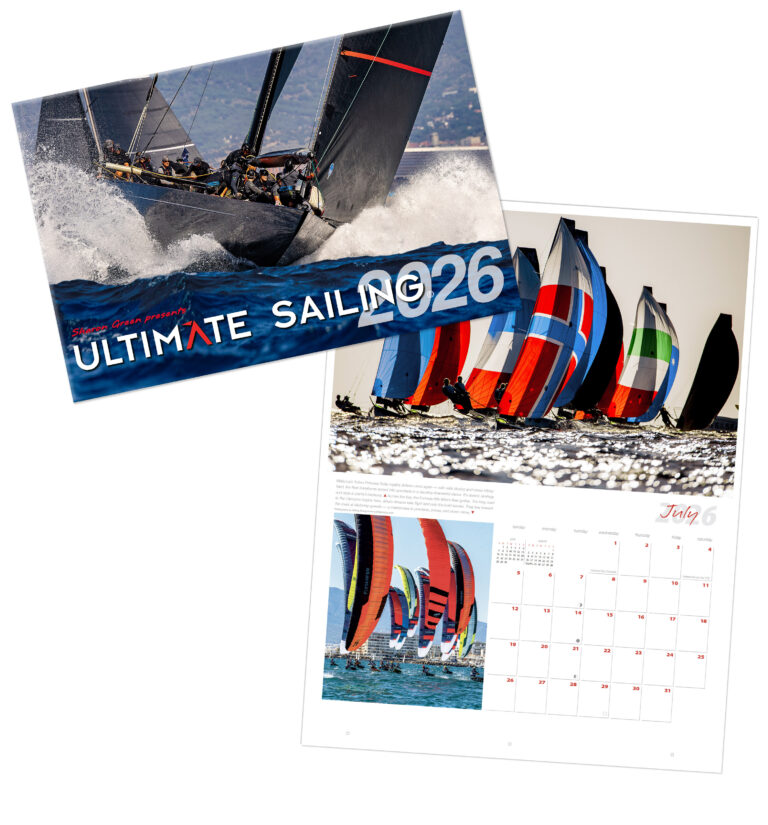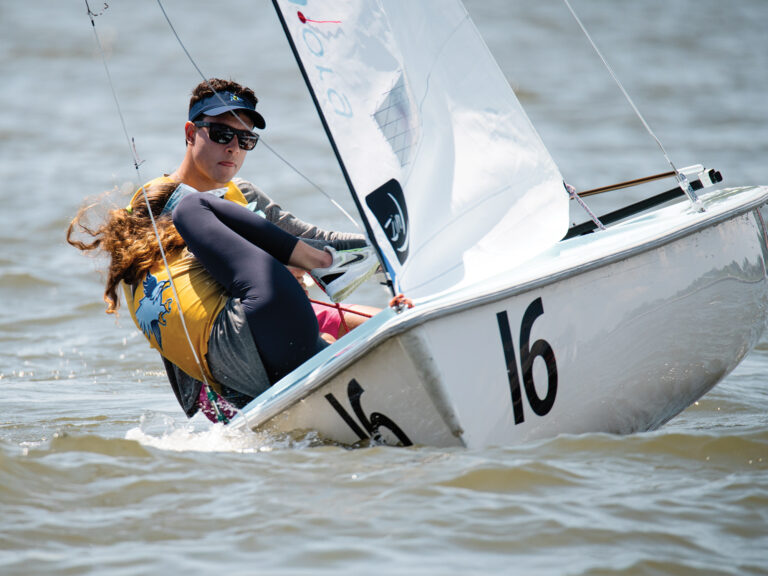
gunboat review
Last summer an e-mailed video clip made the rounds of the sailing community. Set to the Ventures’ classic surf tune “Wipe Out,” it showed a large performance cruising cat, Peter Johnstone’s Gunboat 62 Tribe, tearing past an 80-foot raceboat moving at top speed on a beam reach. The multihull community loved the clip; the maxi-boat’s project manager was less enthused. For many, however, it was a first glimpse of Johnstone’s brainchild, a South African-built, Melvin & Morrelli-designed cat that’s more worthy of the title performance cruiser than almost any other on the water today. Johnstone had spent some time on the largest, fastest cats in the world (Team Adventure, PlayStation), and had previously owned a 68-foot sled refurbished for cruising, so he knew the rewards of high-speed sailing. When he decided his monohull was too uncomfortable when the weather got ugly, he knew the path to follow. The first three Gunboat 62s were built from male tooling, using epoxy andE-glass with carbon-fiber structural components. The fourth, also from male tooling and now being built for an English owner, is made entirely of carbon, and has a taller rig and more sail area than the first three boats. “The other boats were E-glass with carbon for the big bulkheads and the stringers and then Kevlar on the undersides of the hulls,” says Johnstone. “The newer boats are all carbon, but there’s still Kevlar on the bottom and outboard sides of the hulls, and the weight came down about 1,800 pounds. We also extended the boom 2 feet, went up on the mainsail roach, and up on the hounds by about 8 feet.” Johnstone says the changes in construction and sail area were made because the boats keep getting more luxurious and people keep adding more stuff. “We didn’t want to give up any of the sailing performance, and if we could, we wanted to improve upon it.” All four 62s are equipped with a carbon mast and boom-the rigs were originally built by Marstrom, but are now made by Novis Composites, in Conneaut, Ohio-as well as carbon-fiber compression posts and bow sprits, all of which are supported by Aramid fiber rigging sheathed in PVC. As on many modern performance multihulls, there no shackles; instead, there are Spectra lashings everywhere. “We use Spectra because it’s reliable,” says Johnstone, “and when you feel it getting hard, you just throw it out.” We sailed the Gunboat with Johnstone during the passage of an October cold front off Annapolis last year in which we saw windspeeds over 40 knots. The boat handled the big gusts with aplomb, and inside the condo-like structure that serves as the main cabin, galley, and nav station, all was calm. Soda cans placed on tables stayed put, and an Apple Powerbook showing a continuous loop of the “Wipe Out” video sat on its desk unsecured; all this while we were scooting along at speeds up to 17 knots. Serene is a strange word to describe sailing a performance boat in 40 knots of wind and steep chop, but that’s how it felt. The steering station, complete with a helmsman’s seat that looks like a lounge chair on steroids, has 360-degree visibility as well as overhead hatches to monitor mainsail trim. The galley is on the starboard side aft and is delineated by a large storage area, countertop, and bar. On either side of the deckhouse are the entrances to the hulls, where staterooms and heads, offices, stowage, and engines are located. The hulls are narrow, but not so much as to induce claustrophobia, and the emergency exit hatches double as sources of natural light. There are eight watertight bulkheads in each hull. Each interior is custom built so we won’t go into detail; suffice it to say, there’s plenty of room and lots of privacy. Two Saildrive units, powered by 56-horsepower Yanmar diesel engines, poke out through the inside wall of each hull at an angle, so when, and if, you beach the big cat, they won’t get beaten. The twin rudders are mounted in cassettes, and when retracted, allow the boat to float in less than 2 feet of water. Going on deck to work the boat isn’t bad either. We stepped out of the pilot house through a heavy glass door and into a recessed cockpit where everything to manage the headsails and hoist the main is immediately at hand, including the anchor, its rode, and the windlass. There’s even an exterior steering station; a wheel mounted on the same axle as the interior wheel. This is a cockpit in which you’ll feel safe and secure no matter the conditions, and since the helmsman has a great view of the crew, communication is easy. Should you choose to venture out of the cockpit, there’s plenty of trampoline space for lounging, provided you don’t mind the occasional high-velocity dousing. Astern of the deckhouse is a large veranda, with the main traveler mounted on the aft crossbeam, as well as davits for a tender. At the end of each hull is a set of stairs, which makes it easy to board from a dinghy, or when stern-to at a dock. Steering the Gunboat in the big breeze wasn’t a chore, but it could be intense. We hit 18 knots, but breaking the 20-knot barrier won’t be a problem in more moderate conditions. During one stint on the wheel one of our helmsmen was advised, “If you feel the hull go up it’s time to head down hard.” Unlike a beach cat or an ORMA 60 trimaran, these hulls are meant to be in contact with the water, or nearly so, at all times. If you fly a hull there’s a chance of a pitchpole or a capsize, hence the escape hatches. The Gunboat tacked easily in the breeze, but as expected of a large multihull, the boatspeed dropped considerably before we filled sails on the other tack. Sailing the 62-footer was a highlight of the SW Boat of the Year competition, and it left us dreaming about high-speed ocean passages. The Cruising World magazine judges liked it too, crowning it their “Most Innovative Boat.” Johnstone, who now has thousands of miles of Gunboat sailing under his belt, told us what it’s like to sail one offshore. “On the delivery of Tribe to the Caribbean,” he says, “we’re going along in a storm, three or four days of 35 to 45 knots of breeze. The top speed we saw on the speedo was 36.6 knots. We had three reefs in the main and a storm jib up and it was totally relaxing. It’s nice standing watch from inside your studio apartment wearing pajamas and slippers, without even putting on foul-weather gear.” Gunboat 62 LOA 62′ LWL 58′ Beam 28′ DSPL 26,000 lbs. Draft (board up) 2′ Draft (board down) 8’6″ Mainsail 377.2 sq. ft.* Jib 170.5 sq. ft.* Deck gear Harken Mast Marstrom/Novis Designer Morrelli & Melvin Builder Harvey Yachts/ Acheson Rossa Custom Yachts Price $2 million www.gunboat.info.com *now larger

